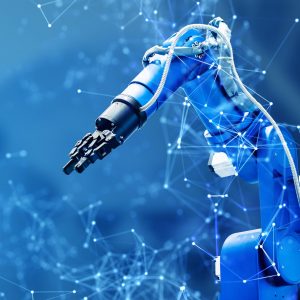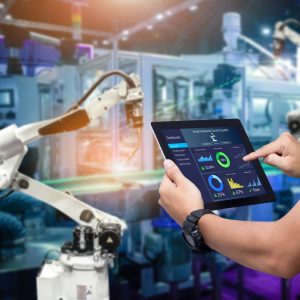
At ABB’s new Shanghai factory, where robots help make robots, robots and other innovative technologies will create a manufacturing spectacle. It represents the newest face of manufacturing: the factory of the future.
ABB’s facility will incorporate many digital technologies, including machine learning, digital, and deep automation. It will not only be a robotics factory, but an R&D center, and allow custom robots to be manufactured per customers’ orders.
The factory of the future is transforming the production floor in many ways. The well-wired factory floor has gone digital. Digitization provides data and enables new, innovative technologies. Factories are more flexible than ever and can adjust to production needs and bring a newfound productivity.
Robust Maintenance and Reduced Downtime
The factory of the future offers data and information to create robust maintenance and reduced downtime. Such data provides the benefit of predictive and reliability-centered maintenance for the physical plant and equipment.
Maintenance management is always important to manufacturing management, and has been growing in sophistication. Industry 4.0 and the dawn of the Internet of Things (IoT), digital twins, and other trends, help maintenance be more disciplined and granular than ever before. And the best is yet to come.
In most any industrial facility, there are many moving parts. Often a plant will run three shifts when demand for production warrants it. This means that the many moving parts are moving 24-7. Hence the fragility of modern manufacturing: if production halts because those many moving parts blink, or fail altogether, production is down. Downtime is the Achilles heel of today’s modern factory. Maintenance greatly influences downtime and uptime.

Because of component wear and failures, a single point of failure can close a manufacturing cell down. While many production lines are designed with adequate redundancy to accommodate one failure, maintenance failures still occur.
This is where Industry 4.0 brings new vitality to the factory floor: it is replete with connected devices and remote platforms that put algorithms and machine learning to work to precisely pinpoint maintenance action. Industry 4.0 aggregates data gathered from devices and feeds them via machine-to-machine communications and the IoT to a focal point or platform. This provides manufacturing leaders with visibility and control.
Increased Uptime, Decreased Downtime
Better maintenance allows a codified and gradual approach to maintenance, whereby equipment is monitored for performance and failures are signaled well ahead of time so corrective maintenance can take place and dreaded downtime of operations is avoided.
In 2016, McKinsey wrote about this topic and said: “”Better management of shutdowns and turnarounds can yield schedule and cost improvements of up to 30 percent.”
They then cited examples of an energy company that reduced annual week-long shutdowns for plant maintenance from an interval of once every 12 months to about 18 months.
It’s all about adding more certainty to an otherwise uncertain science: knowing the optimal time to overhaul plant machinery and equipment as well as when it will fail. Managing with more certainty, using data benchmarking, historical averages, trending, and daily key performance indicators (KPIs), are new ingredients for  healthy production in manufacturing.
healthy production in manufacturing.
Flexibility
In 2020, McKinsey further studied the merits of digital manufacturing, and are as enthusiastic as ever about the benefits of the digital innovations that the factory of the future brings. But they emphasize that it’s not just about data and maintenance. Robotics, virtual reality, automation, and some artificial intelligence, as well as newer manufacturing methods such as additive manufacturing and sustainable practices, all contribute greatly to the digital approach to the factory of the now—and the future.
“The benefits these companies have recorded include 30 to 50 percent reductions of machine downtime, 15 to 30 percent improvements in labor productivity, 10 to 30 percent increases in throughput, and 10 to 20 percent decreases in the cost of quality,” McKinsey stated in an article on this very topic.
The Factory of the Future and Future Market Demand
The factory of the future and the digitization of manufacturing bring better maintenance, less downtime, and more flexibility. Cumulatively, this helps meet market demand.
As for ABB and their up-and-coming robotics manufacturing factory of the future in Shanghai, their president, Sami Atiya, emphasizes embracing automation and everything digital that goes with it so you can ride the market as it gains momentum, rather than chase behind it. “The concept behind this factory is the same advice we give our customers every day: invest in automation solutions that provide flexibility and agility to grow in whichever direction the market goes.”
Editor’s Note: Learn more about digital collaboration platforms and fueling innovation by registering for Dassault Systèmes 3DEXPERIENCE: A Virtual Journey. Our series of online, on-demand episodes deliver thought leadership, actionable content from industry influencers, Dassault Systemes experts, and customers who have implemented 3DEXPERIENCE to meet today’s manufacturing challenges.
Check out the session agendas, and register to watch anytime, anywhere.
3DEXPERIENCE: A Virtual Journey schedule:
- July 29th: Manufacturing and Supply Chain.
- August 26th: Fueling Innovation in the New Agile Enterprise.
- September 23rd: Modeling & Simulation.
- October 14th: Enabling Business Continuity Via the Cloud.

